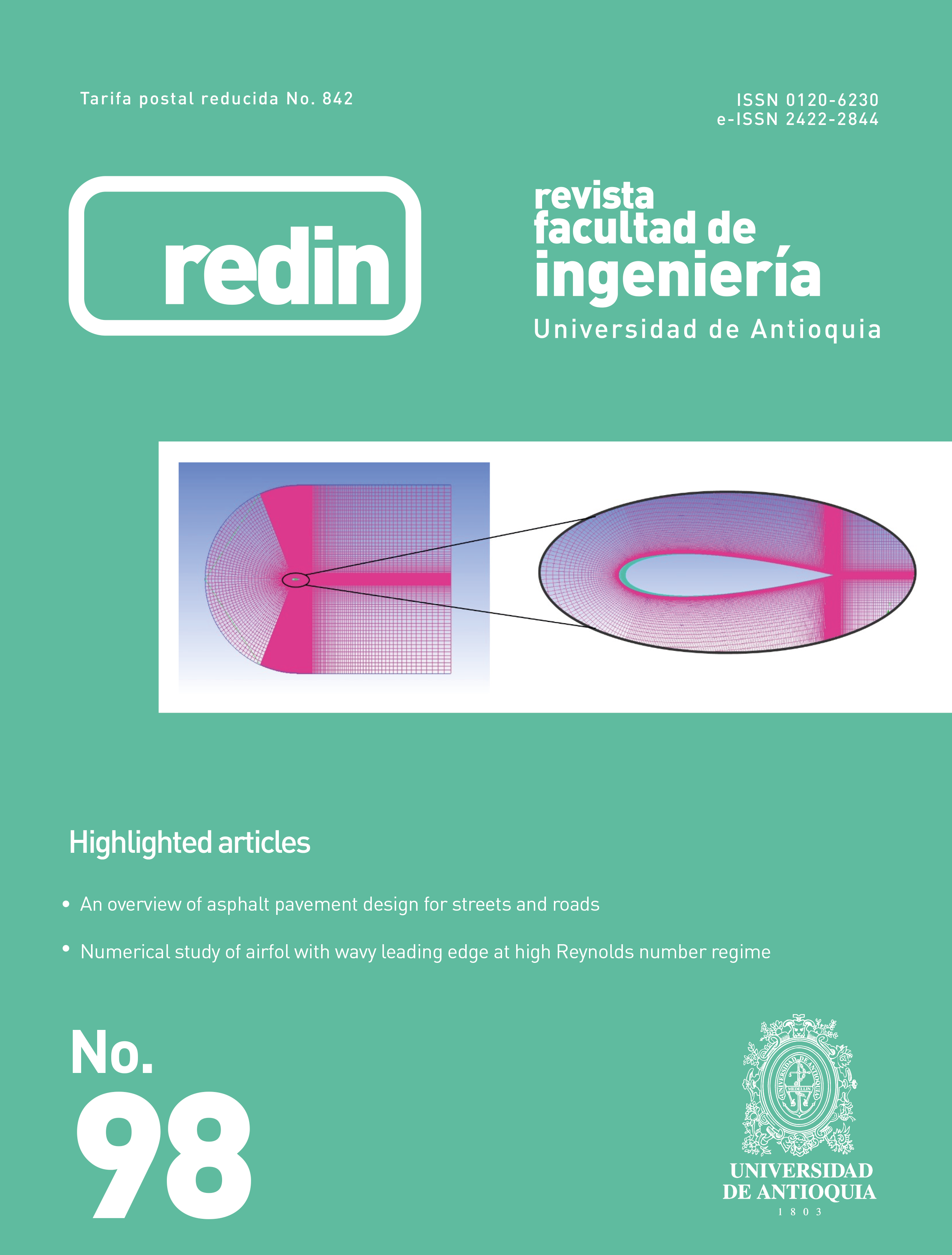Non-intrusive energy disaggregation by detecting similarities in consumption patterns
DOI:
https://doi.org/10.17533/udea.redin.20200370Keywords:
non-intrusive load monitoring, pattern similarities, energy efficiencyAbstract
Breaking down the aggregated energy consumption into a detailed consumption per appliance is a crucial tool for energy efficiency in residential buildings. Non-intrusive load monitoring allows implementing this strategy using just a smart energy meter without installing extra hardware. The obtained information is critical to provide an accurate characterization of energy consumption in order to avoid an overload of the electric system, and also to elaborate special tariffs to reduce the electricity cost for users. This article presents an approach for energy consumption disaggregation in households, based on detecting similar consumption patterns from previously recorded labelled datasets. The experimental evaluation of the proposed method is performed over four different problem instances that model real household scenarios using data from an energy consumption repository. Experimental results are compared with two built-in algorithms provided by the nilmtk framework (combinatorial optimization and factorial hidden Markov model). The proposed algorithm was able to achieve accurate results regarding standard prediction metrics. The accuracy was not affected in a significant manner by the presence of ambiguity between the energy consumption of different appliances or by the difference of consumption between training and test appliances.
Downloads
References
International Energy Agency, “World Energy Outlook 2015,” White paper, 2015.
D. Larcher and J. Tarascon, “Towards greener and more sustainable batteries for electrical energy storage,” Nature Chemistry, vol. 7, no. 1, pp. 19–29, 2015.
R. Ford, “Reducing domestic energy consumption through behaviour modification,” Ph.D. dissertation, Oxford University, 2009.
E. Luján, A. Otero, S. Valenzuela, E. Mocskos, L. Steffenel, and S. Nesmachnow, “Cloud Computing for Smart Energy Management (CC-SEM Project),” in Smart Cities, ser. Communications in Computer and Information Science. Springer, 2019, vol. 978.
E. Orsi and S. Nesmachnow, “Smart home energy planning using IoT and the cloud,” in IEEE URUCON, 2017.
R. Massobrio, S. Nesmachnow, A. Tchernykh, A. Avetisyan, and G. Radchenko, “Towards a cloud computing paradigm for big data analysis in smart cities,” Programming and Computer Software, vol. 44, no. 3, pp. 181–189, 2018.
N. Batra, J. Kelly, O. Parson, H. Dutta, W. Knottenbelt, A. Rogers, A. Singh, and M. Srivastava, “NILMTK: an open source toolkit for non-intrusive load monitoring,” in 5th International Conference on Future Energy Systems, 2014, pp. 265–276.
R. Porteiro, S. Nesmachnow, and L. Hernández, “Short term load forecasting of industrial electricity using machine learning,” in Smart Cities, ser. Communications in Computer and Information Science, S. Nesmachnow and L. Hernández, Eds. Springer, 2019, vol. 1152.
B. Neenan, J. Robinson, and R. Boisvert, “Residential electricity use feedback: A research synthesis and economic framework,” Electric Power Research Institute, 2009.
J. Kelly and W. Knottenbelt, “The UK-DALE dataset, domestic appliance-level electricity demand and whole-house demand from five UK homes,” Scientific Data, vol. 2, 2015.
J. Chavat, J. Graneri, and S. Nesmachnow, “Household energy disaggregation based on pattern consumption similarities,” in 2nd Iberoamerican Congress on Smart Cities, 2019.
M. Figueiredo, A. De Almeida, and B. Ribeiro, “Home electrical signal disaggregation for non-intrusive load monitoring (NILM) systems,” Neurocomputing, vol. 96, pp. 66–73, 2012.
G. Hart, “Nonintrusive appliance load monitoring,” Proceedings of the IEEE, vol. 80, no. 12, pp. 1870–1891, 1992.
R. Bonfigli, S. Squartini, M. Fagiani, and F. Piazza, “Unsupervised algorithms for non-intrusive load monitoring: An up-to-date overview,” in 15th International Conference on Environment and Electrical Engineering, 2015.
J. Kelly and W. Knottenbelt, “Neural NILM: Deep Neural Networks Applied to Energy Disaggregation,” in 2nd ACM International Conference on Embedded Systems for Energy-Efficient Built Environments, 2015, pp. 55–64.
J. Kolter and M. Johnson, “Redd: A public data set for energy disaggregation research,” in Workshop on Data Mining Applications in Sustainability, 2011, pp. 59–62.
A. Soares, A. Gomes, and C. Antunes, “Categorization of residential electricity consumption as a basis for the assessment of the impacts of demand response actions,” Renewable and Sustainable Energy Reviews, vol. 30, pp. 490–503, 2014.
J. Kelly and W. Knottenbelt, “Metadata for Energy Disaggregation,” in The 2nd IEEE International Workshop on Consumer Devices and Systems, Västerås, Sweden, Jul. 2014.
J. Gibbons and S. Chakraborti, Nonparametric Statistical Inference. CRC Press, 2003.
S. Nesmachnow and S. Iturriaga, “Cluster-UY: High Performance Scientific Computing in Uruguay,” in International Supercomputing Conference in Mexico, 2019.
Z. Ghahramani and M. Jordan, “Factorial hidden Markov models,” in Advances in Neural Information Processing Systems, 1996, pp. 472–478.
H. Kim, M. Marwah, M. Arlitt, G. Lyon, and J. Han, “Unsupervised disaggregation of low frequency power measurements,” in SIAM international conference on data mining, 2011, pp. 747–758.
G. Colacurcio, S. Nesmachnow, J. Toutouh, F. Luna, and D. Rossit, “Multiobjective household energy planning using evolutionary algorithms,” in Smart Cities, ser. Communications in Computer and Information Science, S. Nesmachnow and L. Hernández, Eds. Springer, 2019, vol. 1152.
Published
How to Cite
Issue
Section
License
Copyright (c) 2021 Revista Facultad de Ingeniería Universidad de Antioquia

This work is licensed under a Creative Commons Attribution-NonCommercial-ShareAlike 4.0 International License.
Revista Facultad de Ingeniería, Universidad de Antioquia is licensed under the Creative Commons Attribution BY-NC-SA 4.0 license. https://creativecommons.org/licenses/by-nc-sa/4.0/deed.en
You are free to:
Share — copy and redistribute the material in any medium or format
Adapt — remix, transform, and build upon the material
Under the following terms:
Attribution — You must give appropriate credit, provide a link to the license, and indicate if changes were made. You may do so in any reasonable manner, but not in any way that suggests the licensor endorses you or your use.
NonCommercial — You may not use the material for commercial purposes.
ShareAlike — If you remix, transform, or build upon the material, you must distribute your contributions under the same license as the original.
The material published in the journal can be distributed, copied and exhibited by third parties if the respective credits are given to the journal. No commercial benefit can be obtained and derivative works must be under the same license terms as the original work.










 Twitter
Twitter